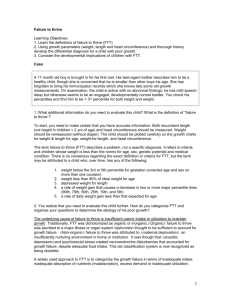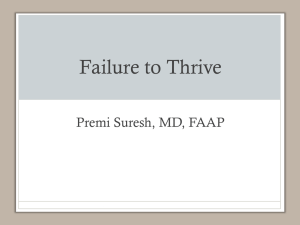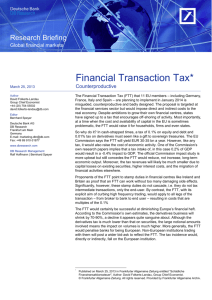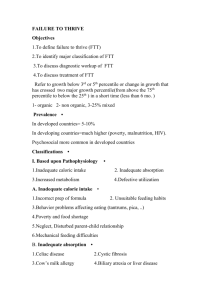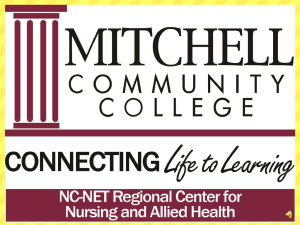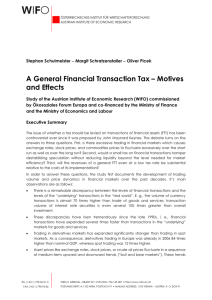Failure to Thrive in the Elderly Population
advertisement
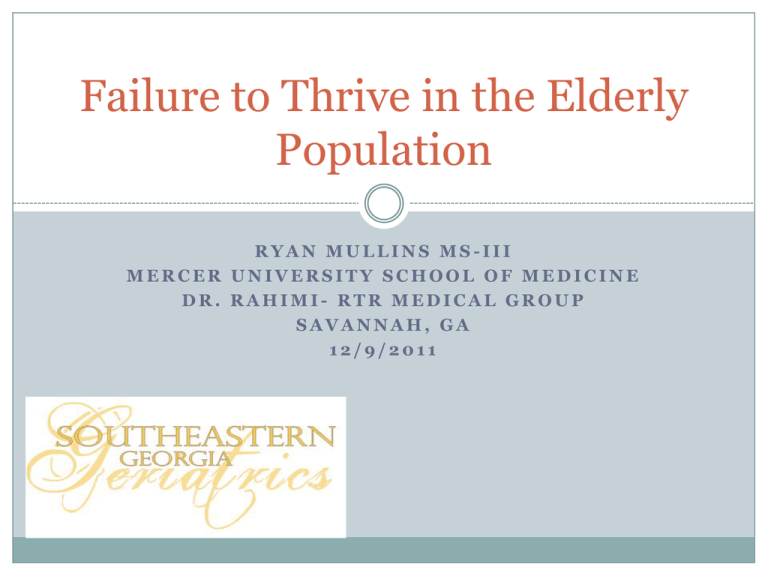
Failure to Thrive in the Elderly Population RYAN MULLINS MS-III MERCER UNIVERSITY SCHOOL OF MEDICINE DR. RAHIMI- RTR MEDICAL GROUP SAVANNAH, GA 12/9/2011 Failure to Thrive (FTT) “The Institute of Medicine defined failure to thrive late in life as a syndrome manifested by weight loss greater than 5 percent of baseline, decreased appetite, poor nutrition, and inactivity, often accompanied by dehydration, depressive symptoms, impaired immune function, and low cholesterol levels.”1 “Failure to thrive should not be considered a normal consequence of aging, a synonym for dementia, the inevitable result of a chronic disease, or a descriptor of the later stages of a terminal disease.” 1 FTT- Pediatrics vs Geriatrics? When people hear the term FTT, most often they think of its use in pediatrics to describe infants who are unable to gain weight, height, or behavioral milestones accepted as normal. What is the difference? Pediatric patients diagnosed with FTT are unable to achieve their expected functional level. Geriatric patients diagnosed with FTT are unable to maintain their functional status. Why Should We Care? The incidence of FTT increases with age and is associated with increased medical care costs and high morbidity/mortality rates. FTT is associated with increased rates of hip fractures, decubitus ulcers, and infection; diminished cell-mediated immunity; and increased surgical mortality rates. FTT will ultimately result in death unless interventions can reverse the course. Components of FTT Physical Frailty 2. Disability 3. Impaired Neuropsychiatric Function 1. FTT may result from the interaction of these three components. Physical Frailty Defined by meeting ≥3 of the following criteria2: Weight loss ≥ 5% of body weight in the last year Exhaustion Weakness (decreased grip strength) Slow Walking Speed (>6-7 seconds to walk 15 feet) Decreased Physical Activity (kcal expenditure/week: males <383 kcal and females <270 kcal) Physical Frailty Weight Loss Clinically significant when there is loss of ≥ 5% of body weight over a period of 6-12 months. 24-29 kg/m2-> Optimal BMI in older adults Unintentional weight loss is associated with decreased functional status, increased complications in the hospital, and poorer quality of life. With normal aging, an increased ratio of fat:lean mass results in small amounts of weight loss each year. This normal weight loss must be distinguished from pathologic weight loss. Neuromuscular function Decreases in skeletal muscle mass and strength, aerobic capacity, and forced expiratory volume are physiologic changes that occur with aging. Disability Defined as, “difficulty or dependency in completing tasks essential for self-care and independent living.”2 Screening involves asking patient about activities of daily living (ADL) and instrumental activities of daily living (IADL). ADLs: Bathing, dressing, toileting, transferring, maintaining continence, and feeding. IADLs: Ability to use the telephone, shopping, food preparation, housekeeping, laundry, mode of transportation, responsibility for own medications, ability to handle finances. Neuropsychiatric Impairment Delirium “an acute disorder of attention and global cognitive function” 2 Prevalent in hospitalized patients with FTT Hospitalization, sensory impairments, severe illness, dementia, volume depletion, and depression greatly increase risk for delirium Dementia Incidence increases rapidly with age. Commonly associated with unintentional weight loss. Depression Most common psychiatric condition in older persons. 1 Signs of depression in elderly patients often misdiagnosed as dementia. Evaluation of Possible FTT Patient An extensive history of the patient should be obtained, including but not limited to: Medical and Psychiatric comorbidities Medications Alcohol/illicit drug use ROS Vision/hearing loss Podiatric and arthritic problems, history of falls in the last year, and any other factors related to poor mobility Factors related to difficulty feeding: tremor, odynophagia, dysphagia, etc. Symptoms of malignancy or chronic infection: fever, pain, sweats, weight loss Factors associated with weight loss: nausea, vomiting, diarrhea, dysphagia, anorexia, abdominal pain Musculoskeletal pain symptoms Social history: social network, family support, living situation, resources, stressors, education, etc. Questions about mistreatment/neglect should be asked without the caregiver in the room. Common Medical Conditions Associated with Failure to Thrive in Elderly Patients Medical condition Cancer Chronic lung disease Chronic renal insufficiency Chronic steroid use Cirrhosis, history of hepatitis Depression, other psychiatric disorders Diabetes Cause of failure to thrive Metastases, malnutrition, cancer cachexia Respiratory failure Renal failure Steroid myopathy, diabetes, osteoporosis, vison loss Hepatic failure Major depression, psychosis, poor functional status, cognitive loss Malabsorption, poor glucose homeostasis, end-organ damage Functional impairment Malabsorption, malnutrition Cardiac failure Hip or other large-bone fracture Inflammatory bowel disease Myocardial infarction, congestive heart failure Previous gastrointestinal surgery Malabsorption, malnutrition Recurrent urinary infections or pneumonia Chronic infection, functional impairment Rheumatologic disease (e.g., temporal arteritis, rheumatoid arthritis, lupus erythematosus) Stroke Tuberculosis, other systemic infection Chronic inflammation Dysphagia, depression, cognitive loss, functional impairment Chronic infection Medications Commonly Associated with Failure to Thrive in Elderly Patients Medication class Anticholinergic drugs Antiepileptic drugs Benzodiazepines Beta blockers Central alpha antagonists Diuretics (high-potency combinations) Glucocorticoids More than four prescription medications Neuroleptics Opioids SSRIs Tricyclic antidepressants Possible effect Cognition changes, dysgeusia, dry mouth Cognition changes, anorexia Anorexia, depression, cognition changes Cognition changes, depression Cognition changes, anorexia, depression Dehydration, electrolyte abnormalities Steroid myopathy, diabetes, osteoporosis Drug interactions, adverse effects Anorexia, parkinsonism Anorexia, cognition changes Anorexia Dysgeusia, dry mouth, cognition changes ADLs http://www.uptodate.com/contents/failure-to-thrive-in-elderly-adults-evaluation IADLs MNA • Must determine access to food as well. • Useful to observe patient eating if possible. Depression Screen • Important to ask about somatic complaints associated with depression as well including: fatigue, poor sleep, loss of appetite, impaired concentration. Physical Exam Important to do thorough PE, paying particular attention to the following: Vitals: HR, BP (supine and standing), RR, T, Weight HEENT: Do thorough examination of mouth looking for sores, dental abscesses, proper fit of dentures etc. Vision/hearing loss screen. Neck Exam- lymphadenopathy, thyroid nodules Breast Exam- masses, axillary lymphadenopathy Rectal Exam- perirectal abscess, fecal impaction Functional Evaluation- Observation of patient undressing/dressing Neurological Exam- DTRs, strength, sensation, proprioception “Get up and go test” MMSE Evaluating Elderly Patients for Failure to Thrive Test Target conditions Blood culture Infection Chest radiography Infection, malignancy Complete blood count Anemia, infection Computed tomography, MRI malignancy, abscess ESR, C-reactive protein levels Inflammation Growth hormone, testosterone (men) Endocrine deficiency HIV, RPR test Infection PPD Tuberculosis Serum albumin and cholesterol levels Malnutrition Serum BUN and creatinine levels Dehydration, renal failure Serum electrolyte levels Electrolyte imbalance Serum glucose level Diabetes Thyroid-stimulating hormone level Thyroid disease Urinalysis Infection, renal failure, dehydration *EKG, Vit B12, Folate, LFT’s, and Vit D also useful, but not in table http://www.aafp.org/afp/2004/0715/p343.html Consults Speech Therapy: may distinguish difficulty with swallowing coordination, difficulty chewing, or difficulty with aspiration. Dietitian: analysis of patient’s caloric intake vs caloric needs. Physical Therapy Occupational Therapy Social Work Treatment of FTT As one can see, FTT can be the result of one disease or a multitude of factors. When a patient is diagnosed with FTT, the clinician should have a discussion with the patient/caregiver regarding patient’s goals of care. Treatment should focus on identifiable disease and should be limited to interventions with few risks. Aggressive interventions should be avoided in these frail patients. FTT typically occurs near the end of a patient’s life, so risk:benefit should be assessed before a treatment is undertaken. Treatment of FTT A team approach may be helpful including a speech therapist, dietitian, physical therapist, mental health professional, and social worker. Resistance and strength exercises result in increased muscle strength. Nutritional supplementation- administration of dietary supplementation between meals. Allow patients to eat what they want. Megace and Marinol may promote appetite. Drugs should be closely monitored if given to a patient. For depression, medications are chosen based on their side effect profile. TCA’s increase appetite, but are limited by their many side effects. SSRIs, with much fewer side effects, are as effective as TCAs at treating depression, but may not be as effective at promoting weight gain. If depression is refractory to treatment, may consider ECT in severe cases. It is very important to review medications and discontinue any that are not necessary in these patients. References Robertson RG, Montagnini M. Geriatric Failure to Thrive. American Family Physician. 2004; 70(2): 343-350. 2. Agarwal, K. Failure to thrive in elderly adults: Evaluation.http://www.uptodate.com/contents/fai lure-to-thrive-in-elderly-adults-evaluation. Topic updated December 20, 2010. 3. Sarkisian CA and Lachs MS. "'Failure to Thrive' in Older Adults." Annals of Internal Medicine 124(12): 1072-1078, 1996. 1.


